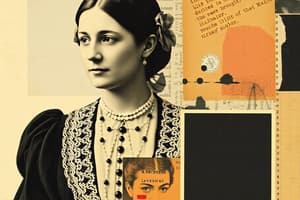Podcast
Questions and Answers
In the early 1800s, women in the U.S. were allowed to serve on juries.
In the early 1800s, women in the U.S. were allowed to serve on juries.
False (B)
By 1837, all colleges that admitted men also admitted women.
By 1837, all colleges that admitted men also admitted women.
False (B)
A married woman in the early 1800s could own property and sign contracts.
A married woman in the early 1800s could own property and sign contracts.
False (B)
The Fourteenth Amendment to the U.S. Constitution specifically granted voting rights to women.
The Fourteenth Amendment to the U.S. Constitution specifically granted voting rights to women.
New Jersey's original constitution, from 1776, allowed all women to vote.
New Jersey's original constitution, from 1776, allowed all women to vote.
Lucretia Coffin Mott was born in January 3, 1793 making her the youngest of all who joined the suffrage movement.
Lucretia Coffin Mott was born in January 3, 1793 making her the youngest of all who joined the suffrage movement.
Lucretia Coffin's family were strict Baptists.
Lucretia Coffin's family were strict Baptists.
Lucretia managed her family store when her mother was away.
Lucretia managed her family store when her mother was away.
At the World Anti-Slavery Convention in 1840, all women were allowed to speak.
At the World Anti-Slavery Convention in 1840, all women were allowed to speak.
Lucretia Coffin was known for her timid and passive behavior.
Lucretia Coffin was known for her timid and passive behavior.
Lucretia stated, 'If our principles are right, why should we be cowards?'
Lucretia stated, 'If our principles are right, why should we be cowards?'
In Millbrook, New York, Lucretia noticed boys received a better education than girls.
In Millbrook, New York, Lucretia noticed boys received a better education than girls.
Lucretia Coffin received less education than most girls of her time.
Lucretia Coffin received less education than most girls of her time.
Lucretia and Elizabeth Cady Stanton first met at a convention in Seneca Falls.
Lucretia and Elizabeth Cady Stanton first met at a convention in Seneca Falls.
More than three hundred people attended the convention on July 19, 1848.
More than three hundred people attended the convention on July 19, 1848.
The Declaration of Sentiments and Resolutions was inspired by the Constitution.
The Declaration of Sentiments and Resolutions was inspired by the Constitution.
Lucretia believed that the demand for the woman's vote was the most important issue to focus on.
Lucretia believed that the demand for the woman's vote was the most important issue to focus on.
Lucretia was dressed in a black and white Quaker dress during the convention.
Lucretia was dressed in a black and white Quaker dress during the convention.
Quakers supported engaging in voting as a way to influence government actions.
Quakers supported engaging in voting as a way to influence government actions.
At the convention, women intentionally barred men from entering.
At the convention, women intentionally barred men from entering.
Lucretia saw that women had significant roles in public life during her time.
Lucretia saw that women had significant roles in public life during her time.
Flashcards
Who was Lucretia Mott?
Who was Lucretia Mott?
An American Quaker activist who dedicated her life to fighting for social justice, particularly abolitionism and women's rights.
What is the Quaker belief in a divine inner spirit?
What is the Quaker belief in a divine inner spirit?
The belief that everyone possesses a divine inner spirit, allowing anyone to speak openly about their experiences in church.
What was Lucretia Mott's stance on slavery?
What was Lucretia Mott's stance on slavery?
The idea that the church should actively engage in the fight against slavery and its immediate abolishment.
What happened at the World Anti-Slavery Convention in 1840?
What happened at the World Anti-Slavery Convention in 1840?
Signup and view all the flashcards
What is the significance of the quote 'If our principles are right, why should we be cowards?'
What is the significance of the quote 'If our principles are right, why should we be cowards?'
Signup and view all the flashcards
What was the school in Millbrook, New York where Lucretia taught?
What was the school in Millbrook, New York where Lucretia taught?
Signup and view all the flashcards
How did Lucretia Mott and other women at the Convention protest?
How did Lucretia Mott and other women at the Convention protest?
Signup and view all the flashcards
How did Lucretia Mott's childhood influence her activism?
How did Lucretia Mott's childhood influence her activism?
Signup and view all the flashcards
Women's suffrage
Women's suffrage
Signup and view all the flashcards
Declaration of Sentiments and Resolutions
Declaration of Sentiments and Resolutions
Signup and view all the flashcards
Opposition to women's suffrage
Opposition to women's suffrage
Signup and view all the flashcards
Pacifism
Pacifism
Signup and view all the flashcards
Pacifist
Pacifist
Signup and view all the flashcards
Seneca Falls Convention organizers
Seneca Falls Convention organizers
Signup and view all the flashcards
Property Rights
Property Rights
Signup and view all the flashcards
Access to Education
Access to Education
Signup and view all the flashcards
What were some of the legal and social restrictions women faced in the early 1800s?
What were some of the legal and social restrictions women faced in the early 1800s?
Signup and view all the flashcards
How did the Fourteenth Amendment impact women's voting rights?
How did the Fourteenth Amendment impact women's voting rights?
Signup and view all the flashcards
What happened to women's voting rights in New Jersey?
What happened to women's voting rights in New Jersey?
Signup and view all the flashcards
How was a married woman's legal status defined in the early 1800s?
How was a married woman's legal status defined in the early 1800s?
Signup and view all the flashcards
What legal protections did a wife have against an abusive or irresponsible husband?
What legal protections did a wife have against an abusive or irresponsible husband?
Signup and view all the flashcards
Study Notes
Lucretia Coffin Mott
- Lucretia Coffin Mott was born on January 3, 1793, and died on November 11, 1880.
- She was a Quaker woman who actively challenged social norms.
- Mott was a strong advocate for women's rights.
- She was locked in a closet as a child. Lucretia and a friend helped her get out of danger.
- Her family owned a store, and Lucretia assisted with running the home and managing the family business in her father's absence.
- Quakers viewed everyone's inner spirit as divinely inspired, leading to women in Quaker communities often speaking in church.
- She taught at a school in Millbrook, New York, in the early 1800s and noted that girls received a lower quality education compared to boys' education.
- Mott felt that females deserve the same educational opportunities as males.
- During the World Anti-Slavery Convention in London, women were restricted from participating.
- Mott met Elizabeth Cady Stanton in 1840, and they formed a friendship and later collaborated on women's rights activism.
- They organized the Seneca Falls Convention in 1848, a pivotal event in the women's suffrage movement.
- The participants drafted the Declaration of Sentiments and Resolutions, which outlined women's rights, reflecting the Declaration of Independence.
- The convention proposed changes for equality of women.
- Some people opposed the idea of immediate abolition of slavery, or they believed that women shouldn't be involved in matters of the state.
- Mott believed in immediate abolition of slavery.
- She believed that women were capable of participating in public life.
- Mott advocated for women's rights in education, social and political life, including working opportunities and the right to vote.
- She believed that women were equal to men and held steadfast to her values.
- Later in her life, Mott was a vocal opponent of the unfair, unequal treatment of women in American society.
Studying That Suits You
Use AI to generate personalized quizzes and flashcards to suit your learning preferences.





